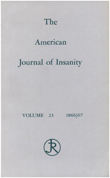Comorbidity of axis I and axis II disorders
Abstract
OBJECTIVE: In light of continuing controversies concerning the DSM-III- R system for diagnosing personality disorders, their construct validity, and the assignment of disorders to a particular axis, the authors studied patterns of axis I-axis II comorbidity. METHOD: Semistructured interviews were used to assess axis I and axis II disorders in 200 inpatients and outpatients. Odds ratios were calculated to determine significant comorbidity between classes of current axis I disorders and axis II personality disorders diagnosed according to two methods and defined at two diagnostic thresholds. Distributions of personality disorder traits were also compared in patients with and without axis I disorders. RESULTS: Significantly elevated odds ratios were found for co-occurrence of current mood disorders with avoidant and dependent personality disorders; anxiety disorders with borderline, avoidant, and dependent personality disorders; psychotic disorders with schizotypal, borderline, and dependent personality disorders; psychoactive substance use disorders with borderline and histrionic personality disorders; and eating disorders with schizotypal, borderline, and avoidant personality disorders. These results held when conservative and liberal definitions of personality disorders were used. Non-specific axis I and axis II associations were confirmed for distributions of personality disorder traits. CONCLUSIONS: Significant associations occurred between most axis I classes of disorders and axis II disorders and traits in more than one cluster. All axis I classes of disorders except mood disorders co-occurred with borderline personality disorder; however, patients with mood disorders had elevated levels of borderline traits. When any personality disorder was present, there were significant odds that a mood, anxiety, psychotic, or eating disorder would also be present; psychoactive substance use disorders, in contrast, significantly co- occurred with borderline and histrionic personality disorders.
Access content
To read the fulltext, please use one of the options below to sign in or purchase access.- Personal login
- Institutional Login
- Sign in via OpenAthens
- Register for access
-
Please login/register if you wish to pair your device and check access availability.
Not a subscriber?
PsychiatryOnline subscription options offer access to the DSM-5 library, books, journals, CME, and patient resources. This all-in-one virtual library provides psychiatrists and mental health professionals with key resources for diagnosis, treatment, research, and professional development.
Need more help? PsychiatryOnline Customer Service may be reached by emailing [email protected] or by calling 800-368-5777 (in the U.S.) or 703-907-7322 (outside the U.S.).



